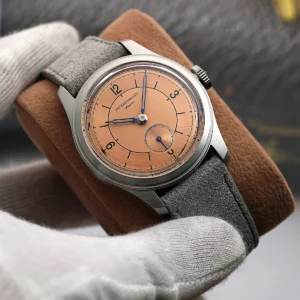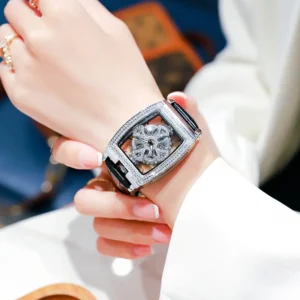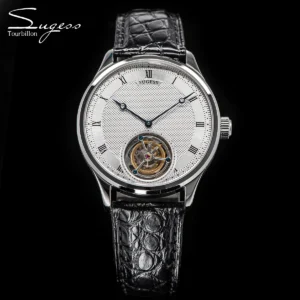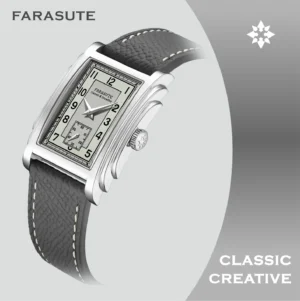What is a Chronograph Watch Movement?
A chronograph watch movement is a specialized mechanical system that enables precise time measurement beyond standard timekeeping. Unlike ordinary watch movements that simply track hours, minutes, and seconds, chronograph movements incorporate additional stopwatch functionality while maintaining regular timekeeping.
The essential components of a chronograph movement include:
- Pushers – Buttons typically positioned at 2 and 4 o’clock that control the start, stop, and reset functions
- Chronograph hands – Dedicated hands (often center seconds and subdial hands) that track elapsed time
- Subdials – Small dials that display measured time intervals (usually seconds, minutes, and sometimes hours)
- Reset mechanisms – Systems that return all chronograph hands to zero when activated
Chronograph movements represent some of watchmaking’s most sophisticated achievements. They contain dozens of additional parts compared to standard movements, requiring precise engineering and assembly to ensure flawless operation. Their enduring popularity speaks to both their practical utility and the horological artistry they represent.
The development of chronograph mechanisms represents a significant chapter in history of specialized watch engineering, showcasing the intersection of precision, functionality, and mechanical ingenuity that continues to captivate watch enthusiasts today.
Integrated vs. Modular: The Two Core Chronograph Architectures
When exploring chronograph movements, the most fundamental distinction lies in their architectural approach: integrated versus modular construction. This difference affects everything from the watch’s profile to its performance characteristics.
| Feature | Integrated Chronographs | Modular Chronographs |
|---|---|---|
| Design Concept | Designed from ground up as chronograph | Base movement with added module |
| Case Profile | Generally thinner, more elegant | Often thicker due to stacked design |
| Pusher Alignment | Typically aligned with crown | May be slightly higher than crown |
| Cost | Generally more expensive | Typically more affordable |
| Serviceability | Complete movement service required | Module can be serviced separately |
| Prestige | Higher horological status | Practical engineering approach |
The choice between these architectures involves tradeoffs between engineering elegance, practical serviceability, and cost considerations. Neither approach is inherently superior – both represent valid solutions to the complex challenge of creating a watch that both tells time and measures elapsed intervals.
A. Integrated Chronograph Movements: Purpose-Built Precision
Integrated chronograph movements represent the purest expression of chronograph design philosophy. These movements are conceived, designed, and manufactured as complete chronograph systems from the beginning, with every component engineered specifically for its timekeeping and chronograph functions.
Key characteristics of integrated chronograph movements include:
- All chronograph components are built into the movement’s main plate rather than added as an afterthought
- The winding, setting, and chronograph mechanisms work in harmony from a single foundation
- Movement thickness is optimized as components can be arranged more efficiently in three-dimensional space
- Pusher action tends to feel more direct and precise due to fewer intermediary parts
The development of integrated chronographs requires significantly more engineering resources and manufacturing complexity, which directly impacts their cost. However, many watch enthusiasts consider this premium justified by the movement’s technical elegance and refined operation.
For collectors seeking the pinnacle of chronograph craftsmanship, our collection of automatic chronograph watches showcases exceptional integrated movements that demonstrate this holistic design approach.
B. Modular Chronograph Movements: Practical Innovation
Modular chronograph movements represent an ingenious engineering solution that has made chronograph functionality more accessible. These movements consist of a standard base timekeeping movement with a specialized chronograph module attached to its top surface.
Key advantages of modular chronograph movements include:
- Lower manufacturing costs through standardization of the base movement
- Easier servicing as the chronograph module can be removed without disassembling the entire movement
- Greater versatility as the same chronograph module can be adapted to different base movements
- Faster development of new chronograph variations by modifying only the module
The most visible tell-tale sign of a modular chronograph is often the positioning of its pushers, which typically sit slightly higher on the case than the crown. While purists might prefer integrated designs, modern modular chronographs have achieved remarkable refinement through continuous innovation.
The practical engineering of modular systems has enabled a wider range of manufacturers to offer chronograph functionality. Explore our chronograph pilot watches to see examples of how modular systems deliver impressive performance within distinctive timepieces.
Actuation Mechanisms: How Chronographs Start, Stop, and Reset
The actuation mechanism is the heart of any chronograph, responsible for controlling the precise starting, stopping, and resetting of the stopwatch function. This system translates the user’s push of a button into the mechanical engagement or disengagement of the chronograph.
Beyond mere functionality, the actuation system significantly impacts the user experience. It determines the feel of the pushers – how much pressure is required, the smoothness of operation, and the tactile feedback when engaged. These qualities contribute significantly to a chronograph’s character and perceived quality.
Two primary actuation systems dominate chronograph design: column wheel and cam-lever (also called coulisse-lever) mechanisms. Each represents a different approach to solving the same mechanical challenge, with distinct advantages and characteristics.
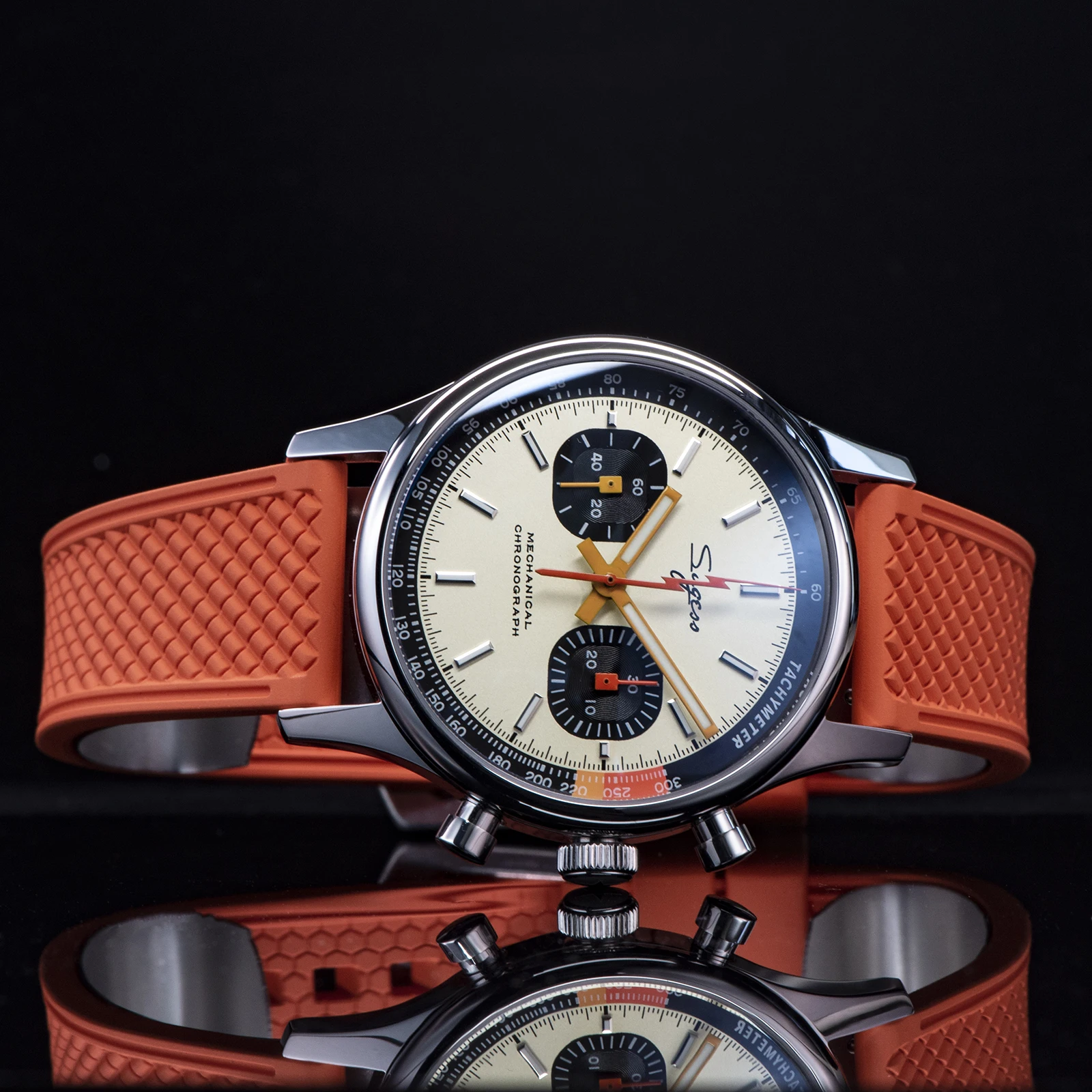
A. Column Wheel Systems: Traditional Precision
The column wheel system represents the traditional and most revered approach to chronograph actuation. At its center is a small, toothed wheel resembling a castle turret, with columns or teeth standing vertically around its perimeter.
When a pusher is pressed, this wheel rotates precisely, allowing levers to fall between or ride upon its teeth, engaging or disengaging various chronograph functions. This elegant mechanism provides several advantages:
- Smoother, more precise pusher operation with less resistance
- More consistent feel throughout the pusher’s travel
- Reduced wear on components due to precise movements
- Visual appeal that watchmakers and collectors appreciate
The manufacturing of column wheels requires exceptional precision, as each tooth must be perfectly formed and positioned. The required machining tolerances and additional hand-finishing contribute significantly to the higher cost of column wheel chronographs.
The intricate design and operation of column wheel systems represent one aspect of the inner workings of chronograph watches that makes these timepieces so fascinating to enthusiasts who appreciate mechanical complexity.
B. Cam-Lever (Coulisse) Systems: Robust Practicality
The cam-lever system (sometimes called coulisse-lever) represents a more modern and industrial approach to chronograph actuation. Instead of a column wheel, this system uses heart-shaped cams and spring-loaded levers to control chronograph functions.
When pushers are activated, the levers move against these specially shaped cams, which guide them into different positions to start, stop, or reset the chronograph. This system offers several practical advantages:
- Greater durability and resistance to shock or mishandling
- Easier mass production with fewer precision-critical components
- Simpler servicing requirements
- Lower manufacturing costs while maintaining reliability
While early cam-lever systems had a reputation for somewhat stiff or inconsistent pusher feel, modern refinements have significantly improved the user experience. High-end cam-lever chronographs can now offer operation nearly as smooth as column wheel systems.
The development of the cam-lever system represents an important chapter in the enduring legacy of chronograph complications, demonstrating how technical innovation has made sophisticated watchmaking more accessible.
Clutch Mechanisms: Engaging the Chronograph Function
The clutch mechanism serves as the critical connection point between a watch’s regular timekeeping train and its chronograph function. When you press the start pusher, the clutch engages, linking these two systems and allowing the chronograph to begin measuring elapsed time.
The design of this clutch system has significant implications for both accuracy and long-term reliability. Two primary approaches have evolved over time: the traditional horizontal clutch and the more modern vertical clutch. Each has distinct characteristics that affect performance and user experience.
A well-designed clutch system should provide:
– Minimal impact on timekeeping accuracy when the chronograph is engaged
– Precise starting and stopping without hesitation or judder
– Resistance to wear over thousands of activation cycles
– Consistent performance throughout the power reserve
A. Horizontal Clutch: Traditional Engineering
The horizontal clutch is the traditional approach to chronograph engagement, using a wheel that moves laterally to mesh with the chronograph train. When activated, a toothed wheel slides horizontally to connect with another wheel in the chronograph mechanism.
This horizontal engagement has several distinctive characteristics:
- The chronograph seconds hand typically “jumps” slightly when started due to the meshing of gear teeth
- The system allows for beautiful visual appreciation through display casebacks
- The design creates less drag on the mainspring when disengaged
- Components are typically larger and more easily serviced
The small but noticeable jump of the seconds hand upon activation is considered by some enthusiasts to be part of the charm of traditional chronographs. It provides visual evidence of the mechanical engagement occurring inside the movement.
B. Vertical Clutch: Modern Precision
The vertical clutch represents a more modern approach to chronograph engagement. Instead of teeth meshing horizontally, two friction plates come together vertically, similar to an automotive clutch system. This design offers several technical advantages:
- The chronograph seconds hand starts without jumping or hesitation
- Less wear over time as there are no teeth that could potentially skip or damage
- More consistent power transmission throughout operation
- Minimal impact on timekeeping accuracy when the chronograph is engaged
The main drawbacks of vertical clutch systems are their increased manufacturing complexity and more compact design, which can make them more challenging to service. However, their performance benefits have made them increasingly popular in high-end chronographs seeking to maximize precision.
Power Sources: What Drives Your Chronograph
The power source of a chronograph movement fundamentally shapes its character, performance, and user experience. Three distinct approaches have evolved over time, each with unique characteristics and appeal.
The energy source not only determines how the watch is powered but also influences its accuracy, thickness, weight, maintenance requirements, and overall ownership experience. Understanding these differences helps in selecting a chronograph that aligns with your preferences and lifestyle.
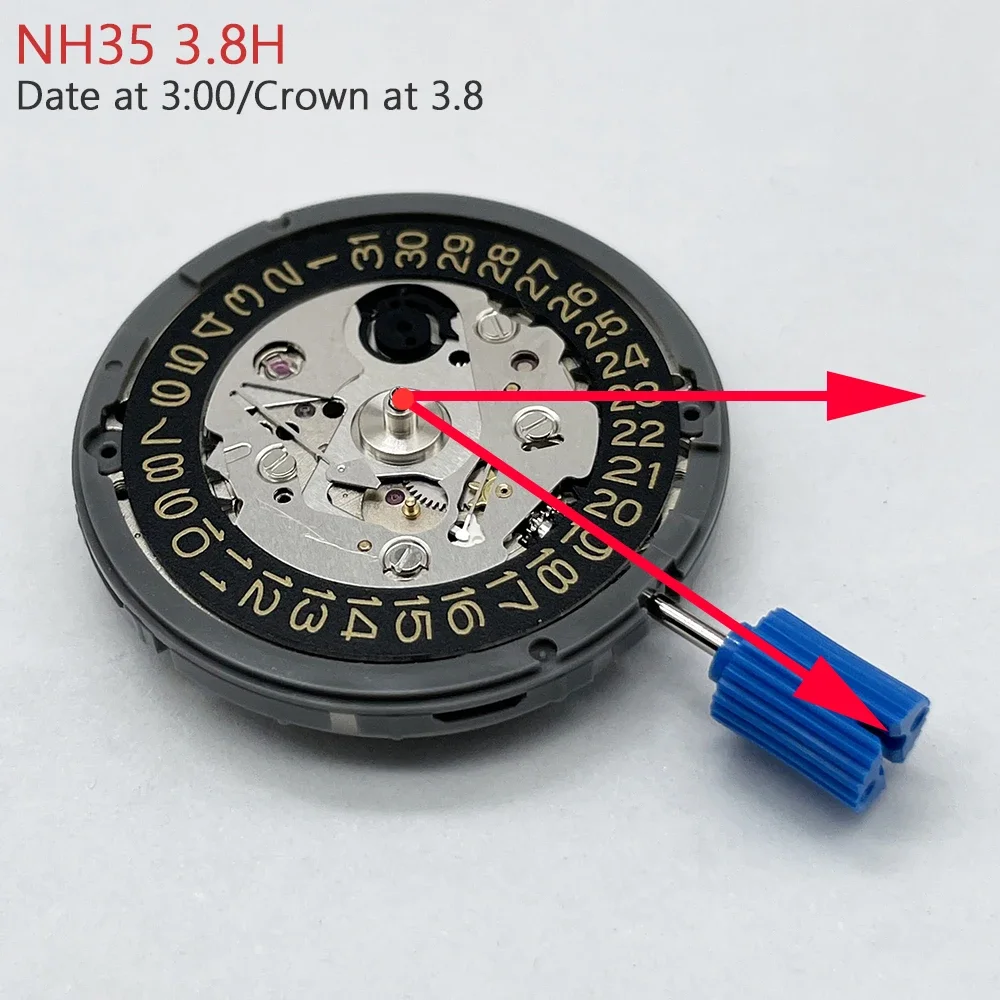
A. Manual-Wind Chronographs: Traditional Engagement
Manual-wind chronograph movements represent the original and most traditional approach to chronograph design. These movements require the wearer to regularly wind the watch’s mainspring by turning the crown.
This intimate interaction between owner and timepiece creates a unique bond that many enthusiasts cherish. Each morning, the ritual of winding connects you physically to the mechanical heart of your chronograph. The process is both tactile and audible, with subtle feedback as the mainspring tension increases.
Manual chronographs typically offer several advantages:
- Thinner case profiles due to the absence of an automatic winding system
- Unobstructed view of the movement through display casebacks
- Simplified mechanics with fewer components that could potentially need service
- Historical authenticity that connects with watchmaking tradition
The typical power reserve ranges from 40-60 hours, meaning the watch must be wound every day or two. This maintenance requirement is viewed by enthusiasts not as a drawback but as part of the charm of owning a truly mechanical timepiece.
Our collection of manual wind watches includes several models that showcase the elegant simplicity and traditional craftsmanship of hand-wound chronograph movements.
B. Self-Winding (Automatic) Chronographs: Modern Convenience
Self-winding or automatic chronograph movements represent a significant technical evolution that brought everyday convenience to chronograph wearers. These movements feature a semicircular rotor that rotates with the natural motion of the wearer’s wrist, automatically winding the mainspring.
This innovation transformed chronographs from specialized instruments requiring daily attention into practical everyday companions. The development of the first automatic chronographs marked a watershed moment in watchmaking history, combining traditional craftsmanship with modern practicality.
Key benefits of automatic chronograph movements include:
- Consistent power delivery without daily winding requirement
- “Always ready” functionality for spontaneous timing needs
- Reduced risk of timing errors due to insufficient winding
- Convenient operation for daily wear
The primary trade-off is increased movement thickness to accommodate the automatic winding system. However, continuous innovation in movement design has progressively reduced this difference, with some modern automatic chronographs achieving remarkably slim profiles.
The technical advancements in self-winding mechanisms parallel similar innovations seen in the evolution of dive watch technology, as both categories evolved to meet the needs of active users.
C. Quartz Chronographs: Precision and Functionality
Quartz chronograph movements represent a complete paradigm shift in timekeeping technology. Instead of deriving power from a wound spring, these movements use battery power and regulate time through the precise oscillations of a quartz crystal.
The introduction of quartz technology democratized chronograph functionality, making precise timing instruments accessible to a broader audience. Today’s quartz chronographs range from basic models to sophisticated analog-digital hybrids with multiple specialized functions.
Key advantages of quartz chronograph movements include:
- Superior accuracy, typically gaining or losing just seconds per month
- Extended functionality including multiple timers, alarms, and digital displays
- Lower acquisition and maintenance costs
- Ready-to-use convenience without winding or wearing to maintain power
While traditionalists may prefer the artistry of mechanical movements, quartz chronographs excel in situations demanding absolute precision, reliability, and resistance to external factors like shock or magnetism. They represent a different but equally valid approach to the challenge of portable time measurement.
Specialized Chronograph Complications and Functions
Beyond the basic stopwatch function, chronograph movements have evolved to include an array of specialized complications and features. These advanced functions transform chronographs from simple timing instruments into sophisticated tools for specialized applications.
These complications represent the pinnacle of watchmaking ingenuity, often requiring hundreds of additional components and extraordinary technical skill to implement. Their presence significantly enhances both the functionality and collectibility of a chronograph.

A. Monopusher Chronographs: Elegant Simplicity
Monopusher chronographs represent both the oldest chronograph design and a statement of elegant minimalism. As the name suggests, these chronographs feature just one pusher (usually integrated into the crown) to control all chronograph functions in sequence.
Pressing the single pusher cycles the chronograph through its operations in a fixed sequence: start → stop → reset. This sequential operation requires a more complex internal mechanism than standard two-pusher designs, despite the outwardly simpler appearance.
The monopusher design creates a cleaner, more symmetrical case profile and connects the wearer to the earliest days of chronograph development. This historical connection, combined with the technical challenge of creating a sequential control system, makes monopusher chronographs particularly appealing to collectors who appreciate horological heritage.
B. Flyback Chronographs: Practical Precision
The flyback chronograph (sometimes called retour-en-vol) features a specialized mechanism that allows the chronograph to be reset and instantly restarted with a single pusher action, without first stopping the timing operation.
In standard chronographs, timing a new event requires three steps: stop, reset, start. The flyback function compresses this into a single action, allowing for the immediate timing of consecutive events – a practical advantage in aviation, racing, and other applications requiring rapid sequential timing.
This functionality requires additional mechanical complexity to ensure the chronograph hands can safely reset while in motion without damaging the movement. The engineering challenge of implementing this feature makes flyback chronographs particularly respected among technical watch enthusiasts.
The practical applications of flyback chronographs are especially valued in aviation, where pilots appreciate essential pilot chronograph features that streamline cockpit operations and allow for more efficient navigation timing.
C. Rattrapante (Split-Second) Chronographs: Ultimate Complexity
The rattrapante or split-seconds chronograph represents one of watchmaking’s most challenging complications. These chronographs feature two superimposed chronograph seconds hands that can measure two events simultaneously.
When activated, both hands run together. Pressing the split pusher stops one hand while the other continues running. Pressing again causes the stopped hand to “catch up” (rattrapante means “catching up” in French) to the running hand. This allows timing of multiple events starting simultaneously but ending at different times, or measuring intermediate times.
The mechanism requires an additional column wheel, clutch, and hand system working in perfect coordination with the primary chronograph. This extreme complexity places rattrapante chronographs among the most prestigious and technically impressive timepieces in existence.
D. Specialized Dial Configurations and Scales
Chronograph dials frequently incorporate specialized layouts and scales that enhance their functionality for specific applications. The arrangement of subdials and the inclusion of calculation scales transform the watch face into a specialized computational tool.
Common dial configurations include:
- Bi-compax layouts with two subdials (typically running seconds and a minutes counter)
- Tri-compax arrangements with three subdials (usually running seconds, minutes counter, and hours counter)
- Quadruple-register designs with four subdials for expanded functionality
These layouts are often complemented by specialized scales printed on the dial or bezel:
- Tachymeter scales for calculating speed based on time over a fixed distance
- Telemeter scales for measuring distance based on the speed of sound
- Pulsometer scales designed specifically for medical professionals to calculate heart rate
The variety of chronograph functions explained in these dial designs demonstrates how chronographs evolved from simple timing devices into sophisticated analog computers designed for specialized professional applications.
Selecting the Right Chronograph Movement Type
Choosing the ideal chronograph movement type requires balancing several factors including budget, intended use, aesthetic preferences, and long-term ownership considerations. Each movement architecture and design offers distinct advantages that may align better with specific needs.
When evaluating chronograph movements, consider these key factors:
- Usage Pattern: How frequently will you use the chronograph function?
- Accuracy Requirements: How precise does your timing need to be?
- Aesthetic Preferences: Do you value seeing the movement through a display caseback?
- Maintenance Considerations: Are you comfortable with regular servicing requirements?
- Budget Constraints: What is your investment range for both purchase and maintenance?
The differences between manual vs automatic chronograph movements represent just one aspect of this decision. Consider this comparative guidance to help identify your ideal match:
| If You Value | Consider This Movement Type |
|---|---|
| Heritage & Tradition | Column wheel, manually-wound integrated chronograph |
| Everyday Practicality | Cam-lever automatic with vertical clutch |
| Maximum Precision | Quartz chronograph with multiple functions |
| Collectibility & Investment | Integrated movement with additional complications |
| Budget-Conscious Quality | Well-made modular automatic chronograph |
Remember that the “best” movement is subjective and depends entirely on your specific needs, preferences, and circumstances. Many enthusiasts eventually acquire several different types to appreciate the unique characteristics each brings to the wrist.
Automatic Chronograph Watches, Chronograph Pilot Watches
Price range: $233.36 through $237.58 Select options This product has multiple variants. The options may be chosen on the product pageAutomatic Chronograph Watches, Classic Style Dive Watches
$3,053.06 Select options This product has multiple variants. The options may be chosen on the product pageClassic Manual Wind Watches, Manual Wind Dress Watches
Price range: $425.50 through $462.50 Select options This product has multiple variants. The options may be chosen on the product page- $104.12 Select options This product has multiple variants. The options may be chosen on the product page
Automatic Skeleton Watches, Classic Manual Wind Watches, Manual Wind Dress Watches, Mechanical Skeleton Watches
$1,944.80 Select options This product has multiple variants. The options may be chosen on the product pageClassic Manual Wind Watches, Manual Wind Dress Watches, Square & Rectangular Automatic Watches
$884.95 Select options This product has multiple variants. The options may be chosen on the product page
Caring for Your Chronograph Movement
Proper maintenance ensures your chronograph will provide decades of reliable service while preserving both functionality and value. Chronograph movements, with their additional complexity compared to time-only watches, benefit from thoughtful care routines.
Follow these guidelines to maximize the longevity of your chronograph movement:
Regular Service Intervals: Have mechanical chronographs professionally serviced every 5-7 years, even if they appear to be running well. This preventative maintenance can identify issues before they cause damage.
Proper Operation: Always ensure the chronograph is fully reset before adjusting the time or date. Setting the watch while the chronograph is running can damage the gear train.
Careful Timing: Avoid leaving mechanical chronographs running constantly. While occasional use is beneficial to distribute lubricants, extended continuous operation increases wear.
Pusher Care: Use chronograph pushers with deliberate, firm pressure rather than aggressive force. The internal mechanisms are precisely engineered and not designed for harsh manipulation.
Water Resistance Maintenance: Have water resistance tested annually if you use your chronograph near water. Chronograph pushers create additional potential entry points for moisture.
Storage Consideration: Store unworn mechanical chronographs flat or in winders to maintain even distribution of lubricants. Consider dehumidified storage for valuable pieces.
Magnetism Awareness: Keep chronographs away from strong magnetic sources which can affect timing accuracy and potentially magnetize components.
For quartz chronographs, prompt battery replacement by a qualified technician will prevent potential damage from battery leakage while maintaining water resistance seals.
The Future of Chronograph Movement Technology
The world of chronograph movements continues to evolve through a fascinating blend of traditional craftsmanship and cutting-edge innovation. While respecting centuries of mechanical watchmaking heritage, manufacturers are embracing new materials, manufacturing techniques, and design concepts to advance chronograph performance.
Recent innovations shaping the future of chronograph movements include:
Advanced materials like silicon and carbon composites are revolutionizing key components, reducing friction, eliminating magnetism concerns, and extending service intervals. These materials allow for lighter, more efficient movements with improved chronometric performance.
Manufacturing techniques including LIGA fabrication and advanced CNC machining enable previously impossible component designs with microscopic precision. These technologies are democratizing features once reserved for only the most exclusive chronographs.
Power reserve innovations through optimized mainsprings and more efficient gear trains are extending the operating time of mechanical chronographs. Some modern designs now achieve 60-80 hours of power reserve while maintaining chronometric stability.
Despite these technological advances, the soul of the mechanical chronograph remains unchanged. There’s something profoundly satisfying about pressing a pusher and watching the precise dance of hands begin – a physical connection to time measurement that digital alternatives cannot replicate.
The enduring appeal of mechanical chronographs in a digital age speaks to their status as more than mere timekeeping tools. They represent the perfect marriage of art and engineering – functioning sculptures that capture humanity’s relationship with time in a tangible, wearable form.
As technology continues advancing, mechanical chronographs will likely embrace helpful innovations while maintaining the core attributes that make them special. This balance ensures these remarkable timepieces will continue fascinating enthusiasts and collectors for generations to come.




